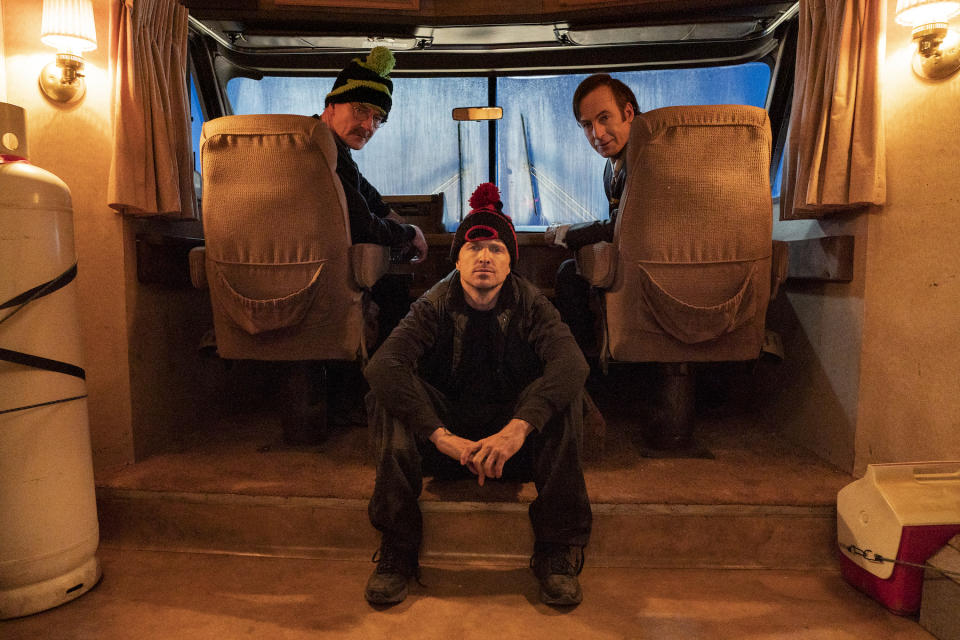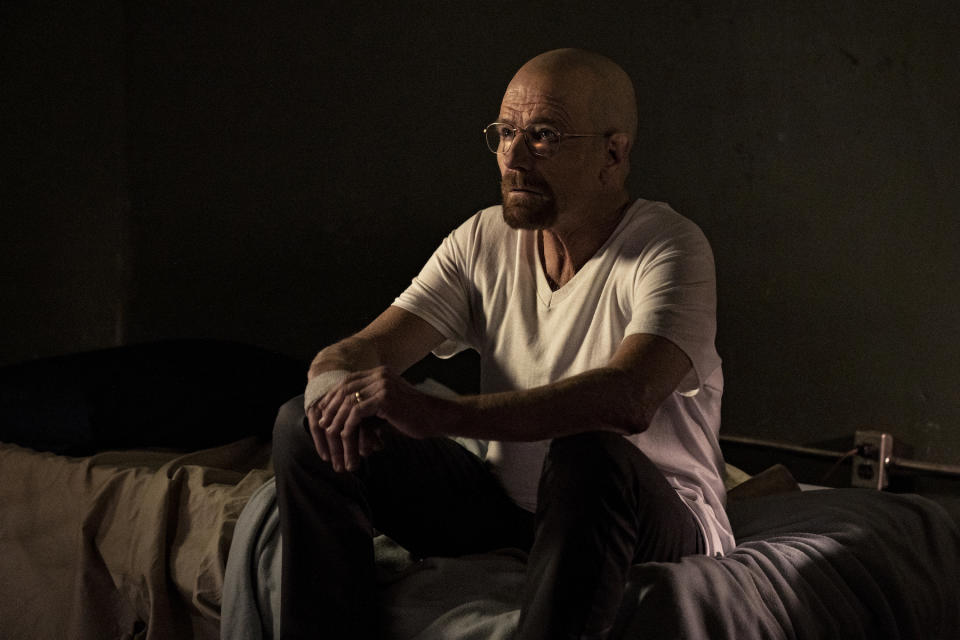‘Better Call Saul’ Found the Perfect Way to Make ‘Breaking Bad’ Part of Its Goodbye

“Better Call Saul” had all the means to relitigate “Breaking Bad.” There was a courtroom and witnesses and the eager attention of every viewer keen on seeing where Saul Goodman’s (Bob Odenkirk) fate would end up in relation to his former clients’. But as it did, time and again over the course of its six-season run, the “Better Call Saul” finale opted for a road of its own choosing.
At the same time, “Better Call Saul” was never going to be able to ignore its fellow Albuquerque show completely. Doing so would fall somewhere between foolishness and hubris. The idea that Jimmy McGill’s own turn for the worse could come fully independently of another six-season arc in recent memory, involving some of the same key players, just wasn’t feasible.
More from IndieWire
The Sweet Story Behind Rhea Seehorn's *Other* Emmy Nomination
'Breaking Bad' Statues Slammed by New Mexico Republicans for 'Glorifying Meth Makers'
So co-creators Peter Gould and Vince Gilligan helped fashion a show that was less a sibling living in a shadow and more a friend shaking hands with a neighbor. Outside of the canon already laid out in “Breaking Bad,” “Better Call Saul” took the details and ideas that made sense without having to serve as a pure carbon copy. That philosophy showed up in the finale in Saul Goodman’s waning moments.
“The first time Saul Goodman meets Walter White, he says ‘My name is McGill.’ And then the last thing he says in the courtroom is ‘My name is McGill.’ That’s another interesting way in which, on-screen, the character declares himself to be this one, best version of himself. Owning his choices and who he’s been,” Odenkirk told press on Tuesday morning.
That courtroom confession is also tangled up in the idea of consequences. With the Time Machine threads that run through the rest of the finale “Saul Gone,” it would be tempting to use this episode to right some wrongs or clear up any past ambiguities. But everyone who shows up to Saul’s hearing is there in the service of showing the impact of one person’s actions. It’s not an excuse to just bring Betsy Brandt back. When the sentence is being considered, Marie is sitting next to Blanca Gomez (Marisilda Garcia).

Greg Lewis/AMC/Sony Pictures Television
Most of the characters the show could have potentially brought back are either dead or fled. But even in Jimmy’s legal circles, “Better Call Saul” kept that last sentencing hearing from being a full-on, “This is Your Life”-style reunion. There’s no Schweikart, no Cliff Main, no Cheryl Hamlin. That same “just because they can, doesn’t mean they should” ethos extends to how Season 6 threaded in its “Breaking Bad” callbacks.
Walt and Jesse appear in two sequences each. The first, a nod to the “Better Call Saul” episode of “Breaking Bad” is the show’s origin story in miniature. Look at it one way and it’s a tiny victory lap for the “Saul” writers’ ability to spin entire seasons’ worth of drama out of a single line of panic-induced dialogue (“It wasn’t me, it was Ignacio! He’s the one!…Lalo didn’t send you?“). But it’s also in service of seeing Saul through other people’s eyes, tracking that pair’s first collective impression and showing how close and how far Saul is to the Jimmy we met all the way back in “Uno.”
It’s when the two characters get their own flashbacks that “Better Call Saul” gets the full picture. Jesse meets Kim Wexler outside the Saul Goodman strip mall office, while Walt holes up with Saul underneath the vacuum shop. They’re the bookends of Saul’s journey. Jesse gets a first impression of Saul via the woman who knows him best. Walt, after knowing him as a client, declares that he’s “the last lawyer I’d have gone to” for an intellectual property suit. That Time Machine talk was a vehicle for talking about regrets, but regrets don’t exist if you can delude yourself into thinking you have no need for them.
“So you were always like this,” Walt hurls at Saul in between coughing fits. “Better Call Saul” is basically a six-season investigation of how true that statement is. It’s the animating force behind the entire project, to see if a character who admits that he’s basically two different people from the outset in “Breaking Bad” is more the person he became or the person he left behind. Bringing back “Breaking Bad” characters at the show’s end wasn’t simply a nostalgia play. It was the show wrestling with its own power to change the future.
If the ending of “Better Call Saul” is following in any particular ABQ tradition, it’s “El Camino.” The 2019 feature-length addition to this saga was another story that didn’t fit neatly into the “Breaking Bad” timeline, picking and choosing what parts to revisit as a means of considering a character in full. On Tuesday, Gould referred to these three projects as its own kind of trilogy, stories that rhyme with each other in parts but end up reaching distinct conclusions.

Greg Lewis/AMC/Sony Pictures Television
“Walt dies, he was always going to do. That was set from the beginning. He dies on his own weird twisted terms, Jessie suffers greatly. He’s in a prison of his own for quite a while, and then he gets away and starts this healing,” Gould said. “Of the three of them, Jimmy gets his soul back, but he’s going to be incarcerated for some amount of time. That just felt right that these three — heroes, antiheroes, whatever you want to call them — these protagonists each have their own ending.”
Of course, “Better Call Saul” was a balancing act far before its farewell episodes. In some ways, it’s easy to overlook Gus Fring and Mike Ehrmantraut as “Breaking Bad” carry-overs, given how much both exist in “Better Call Saul” as independent figures. They both arrive in Walter White’s life having lost so much of themselves. Watching them in the moments before that happens, trying to regain at least a little bit of that dignity and humanity, is another case of “Better Call Saul” managing to add depth to preexisting characters without having to rewrite their histories.
It’s a practice that’s emphasized in each of their final on-screen moments. The finale teaser harkens back to “Bagman,” with Jimmy’s trusty Suzuki in the ditch and no end to the desert in sight. In Jonathan Banks’ last on-screen moments as Mike, the character makes an explicit reference to taking a bribe, the first step that led the former cop on a journey to watching his own soul slowly get chipped away, bit by bit. In a similar way, Gus (Giancarlo Esposito) sitting at the wine bar becomes the kingpin version of Tantalus, living life just beyond the warm company and delicious glass of red that he can never actually enjoy. His illegal business ventures put him in a state of danger, keeping him from things you can see would truly make him happy.
Life makes us juggle different parts of ourselves, whether by invitation or demand. In that way, the main protagonists in both “Breaking Bad” and “Better Call Saul” were the centers of their stories, but their struggles were shared ones, so much so that a character on the periphery could support a biography of their own. Saul got the spinoff, and Kim arguably got one of her own in the “future” part of Season 6.
In the end, “Better Call Saul” wasn’t completely beholden to what came before. Much like Jimmy asserting himself over the Saul Goodman name, the show’s success doesn’t erase everything that came before. “Better Call Saul” living and ending on its own terms isn’t a negation of the Walter White era that came before it. Nor does it make it inherently superior or inferior. The best part about having these, alongside the impressive-in-its-own-way “El Camino,” is that they can all coexist. The beauty of “Better Call Saul” is that it allows you to make your own choice of where to start.
Best of IndieWire
‘The Lord of the Rings’: Everything You Need to Know About Amazon’s Big Money Adaptation
Charlie Cox and Vincent D'Onofrio Set to Reprise 'Daredevil' Roles for Marvel Series 'Echo'
'The Last of Us': Everything You Need to Know About HBO's Adaptation
Sign up for Indiewire's Newsletter. For the latest news, follow us on Facebook, Twitter, and Instagram.

 Yahoo Movies
Yahoo Movies 